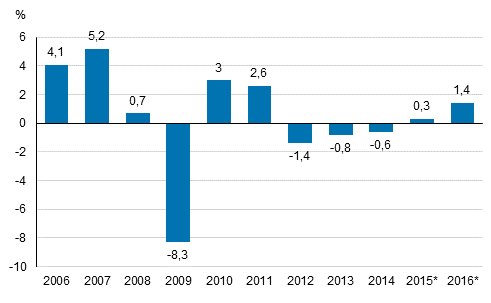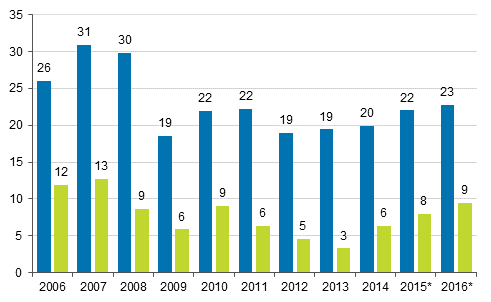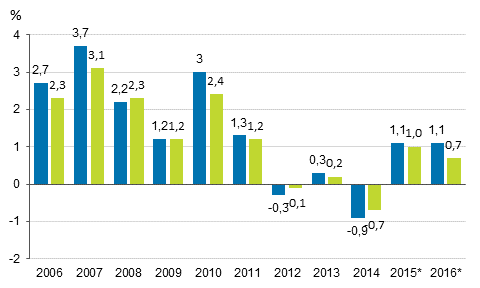1. Gross domestic product grew by 1.4 per cent in 2016
The volume of GDP grew by 1.4 per cent in 2016. The growth rate became slightly revised from the data published in early March (was 1.6 per cent). Last year, GDP that describes the output of the national economy stood at EUR 214 billion.
Figure 1. Annual change in the volume of gross domestic product, per cent

The demand of the national economy went up by 1.7 per cent last year. Demand was particularly raised by an increase in investments and in households’ consumption expenditure. Investments were 5.2 per cent higher than one year previously. The volume of private consumption went up by two per cent and public consumption by 0.5 per cent. The volume of exports grew by 0.5 per cent and that of imports by 2.5 per cent.
1.1 National income increased in real terms
Net national income grew by 2.9 per cent in nominal terms but by two per cent in real terms last year because the terms of trade weakened. National income per capita was EUR 32,000. Finland's gross national income amounted to EUR 216 billion last year. Gross national income grew by 1.4 per cent in real terms.
Households’ wage and salary income went up by 1.6 per cent and employers’ social insurance contributions by 2.6 per cent. In all, the share of compensation of employees in national income was 59.1 per cent, as against 59.8 per cent in the year before. Property and entrepreneurial income in the national economy increased by 4.3 per cent and its share of the national income rose to 24.8 per cent.
1.2 Enterprises' financial position improved
Non-financial corporations' operating surplus describing profits from their actual operations went up by 3.4 per cent from the previous year. Non-financial corporations’ entrepreneurial income also increased by 3.4 per cent as property expenditure paid by enterprises declined more than property income received. Entrepreneurial income also takes into consideration property income and paid interests and rents, and corresponds roughly with profit before payment of taxes and dividends.
Figure 2. Non-financial corporations, operating profit from the operations proper before payment of taxes and dividends, etc. (= operating surplus, left column) and after (= net saving, right column), EUR billion.

Non-financial corporations paid eight per cent more direct taxes last year than in the previous year. Non-financial corporations are estimated to have paid five per cent less dividends. Non-financial corporations’ net lending, or financial position, showed a surplus of EUR 8.2 billion, as against EUR 7.9 billion in the previous year.
The financial position of financial and insurance corporations showed a deficit of EUR 0.5 billion while it was EUR 0.1 billion in the previous year. Financial corporations’ interest income (financial intermediation services indirectly measured) remained unchanged and commission income increased by two per cent. Because the compensation of employees paid by financial and insurance corporations and intermediate consumption grew more than income, the operating surplus decreased by 19 per cent.
1.3 General government deficit 1.9 per cent of GDP
General government’s net lending, or financial position, showed a deficit of EUR 4.1 billion, while the deficit was EUR 5.7 billion in the previous year. The deficit amounted to 1.9 per cent relative to GDP. In the previous year, the deficit amounted to 2.7 per cent of GDP.
Last year, the financial position of central government showed a notable deficit for the eight successive year. The deficit (net borrowing) was EUR 5.9 billion, while one year before it was EUR 6.3 billion.
State revenues from taxes went up by 3.9 per cent. Revenue grew most from the vehicle and car tax, income tax from corporations and households, energy taxes and tobacco tax. Tax revenue was decreased by a decline in death duty and gift tax.
Current transfers to local government (incl. repayments of value added tax) went up by 2.9 per cent. Current transfers to social security funds grew by 2.5 per cent. Central government's consumption expenditure increased by 4.1 per cent and investments by 1.9 per cent.
The deficit or net borrowing of local government (municipalities and joint municipal authorities, etc.) was EUR one billion, having been EUR 1.3 billion in the year before. Tax revenues received by municipalities went up by only 0.4 per cent. Final consumption expenditure went up by 0.8 per cent in nominal terms and gross fixed capital formation is estimated to have declined by 1.3 per cent.
The surplus of employment pension schemes decreased from the previous year. The surplus was now EUR 2.3 billion, while one year before it was EUR 2.7 billion. The surplus does not include holding gains in assets. Revenues from pension contributions grew by 0.7 per cent and employment pensions paid by employment pension funds went up by 3.6 per cent mainly as a result of an increase in the number of pensioners. Other social security funds showed a surplus of EUR 0.5 billion after two years in deficit mainly due to an increase in received unemployment insurance contributions.
Figure 3. General government surplus/deficit, per cent of GDP

The so-called EDP debt, or consolidated gross debt, of general government went up by EUR 2.7 billion to EUR 136 billion. The debt was 63.6 per cent relative to gross domestic product at the end of 2016. Statistics Finland will publish the deficit and debt data to be reported to the European Commission on 31 March 2017. The deficit and debt data published here may become revised in that connection.
General government's share of the gross value added was 19.8 per cent, having been 20.4 per cent one year earlier. The proportion of total public expenditure to GDP dropped to 56.1 per cent. In the previous year, the proportion was 57.0 per cent. Total public expenditure includes a notable amount of internal public sector expenses that are included in the calculations twice.
The tax ratio, or the ratio of taxes and statutory social security contributions to GDP, was 44.3 per cent last year. The tax ratio increased by 0.4 percentage points from the previous year.
1.4 Households’ real income grew by 1.1 per cent
In 2016, households’ disposable income increased by 1.6 per cent in nominal terms and by 1.1 per cent in real terms. Households’ adjusted disposable income increased by 1.4 per cent in nominal terms and by 0.7 per cent in real terms. Adjusted income also takes into consideration welfare services, i.e. the individual services that general government and organisations produce for households, such as educational, health and social services.
Figure 4. Annual change in households’ disposable real income (left column) and household's adjusted real income (right column), per cent.

Wages and salaries received by households went up by 1.6 per cent and social benefits by 2.1 per cent. The wages and salaries sum went up due to the risen level of earnings and a slight improvement in employment. Social benefits increased because the number of pensioners grew. Households’ property and entrepreneurial income decreased by 7.8 per cent.
Direct taxes paid by households and compulsory social security contributions increased by 1.8 per cent. Final consumption expenditure grew by 2.7 per cent in nominal terms. The savings rate, i.e. the ratio of savings to disposable income, turned negative in 2016, to -1.0 per cent.
Households’ fixed investments primarily in dwellings increased by 12.2 per cent in nominal terms. The financial position of households showed a deficit of EUR 6.4 billion, while the deficit in the previous year was EUR 3.9 billion.
Households' indebtedness ratio grew further and stood at 126.5 per cent at the end of 2016, which was two percentage points higher than one year earlier. The indebtedness ratio expresses the ratio between the loans and annual disposable net income in accordance with financial accounts. Annual financial accounts data on the situation at the end of the year are preliminary assessments.
1.5 Current account still shows a deficit
Last year, Finland's current account was EUR 2.8 billion in deficit, which was the sixth year running of being in deficit. When imports are also valued at FOB price (at the border of the exporting country) and not at CIF price (at the border of the importing country), as is done in the foreign trade statistics of Finnish Customs, the goods trade showed a surplus of EUR 0.5 billion. However, the balance of services trade showed a deficit of EUR 3.1 billion.
EUR 1.6 billion more property income was received from the rest of the world than was paid there. The current transfer outflow was clearly higher than the received income transfers.
The data on property items and international trade in services are very preliminary.
1.6 Next revisions in June and July 2017
National accounts data concerning the first quarter of 2017 will be released on 1 June 2017. National Accounts for 2016 with more detailed data contents will be released on 13 July 2017.
These preliminary data are based on the information on economic development available by 8 March 2017. More information on the national accounts methods can be found on Statistics Finland’s website.
Source: National Accounts 2016, preliminary data. Statistics Finland
Inquiries: Tuomas Rothovius 029 551 3360, Pekka Tamminen 029 551 2460, kansantalous@stat.fi
Director in charge: Ville Vertanen
Updated 16.3.2017
Official Statistics of Finland (OSF):
Annual national accounts [e-publication].
ISSN=1798-0623. 2016,
1. Gross domestic product grew by 1.4 per cent in 2016
. Helsinki: Statistics Finland [referred: 19.4.2025].
Access method: http://stat.fi/til/vtp/2016/vtp_2016_2017-03-16_kat_001_en.html

